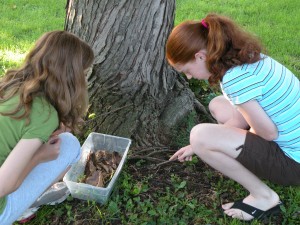For Slugs’ Sake: Making a Refuge for Slugs, Bugs and Other Invertebrates

Originally appears in the Winter 2009-2010 issue
Invertebrates are the most abundant and diverse group of animals on earth, and yet many students know little about these creatures. They may think that some invertebrates look slimy or may fear being stung or jumped at, and yet be unaware that invertebrates serve a major role in recycling nutrients by decomposing organic material. We tend to hear about the damage that invertebrates do to crops and trees, but we hear less about the good things that they do, such as pollinating plants and serving as a food source for the higher animals that we do like.
A study of invertebrates provides excellent opportunities for students to improve their science skills and become more aware of the natural world around them. In this extended exercise, students learn about the characteristics and habitat requirements of invertebrates by making observations, creating a habitat for invertebrates, and designing and conducting investigations. Slugs were chosen as the focus of several of the activities because many people have negative attitudes towards slugs. However, students may choose to work with any invertebrates. While the activities are most suitable for middle school, they could be adapted to any level and have been used in cooperative lessons between a high school class and an elementary class.
The goals of the unit are for students to:
- develop an appreciation for nearby nature areas
- learn about a misunderstood organism (slugs)
- practice research, writing and presentation skills
- become “experts” on one invertebrate organism
- learn about habitat structure and construction.
This content is restricted to subscribers only.
If you are not yet a subscriber, please consider taking out a subscription here.
If you are an existing subscriber, kindly log in or contact us at info@greenteacher.com for more information.










